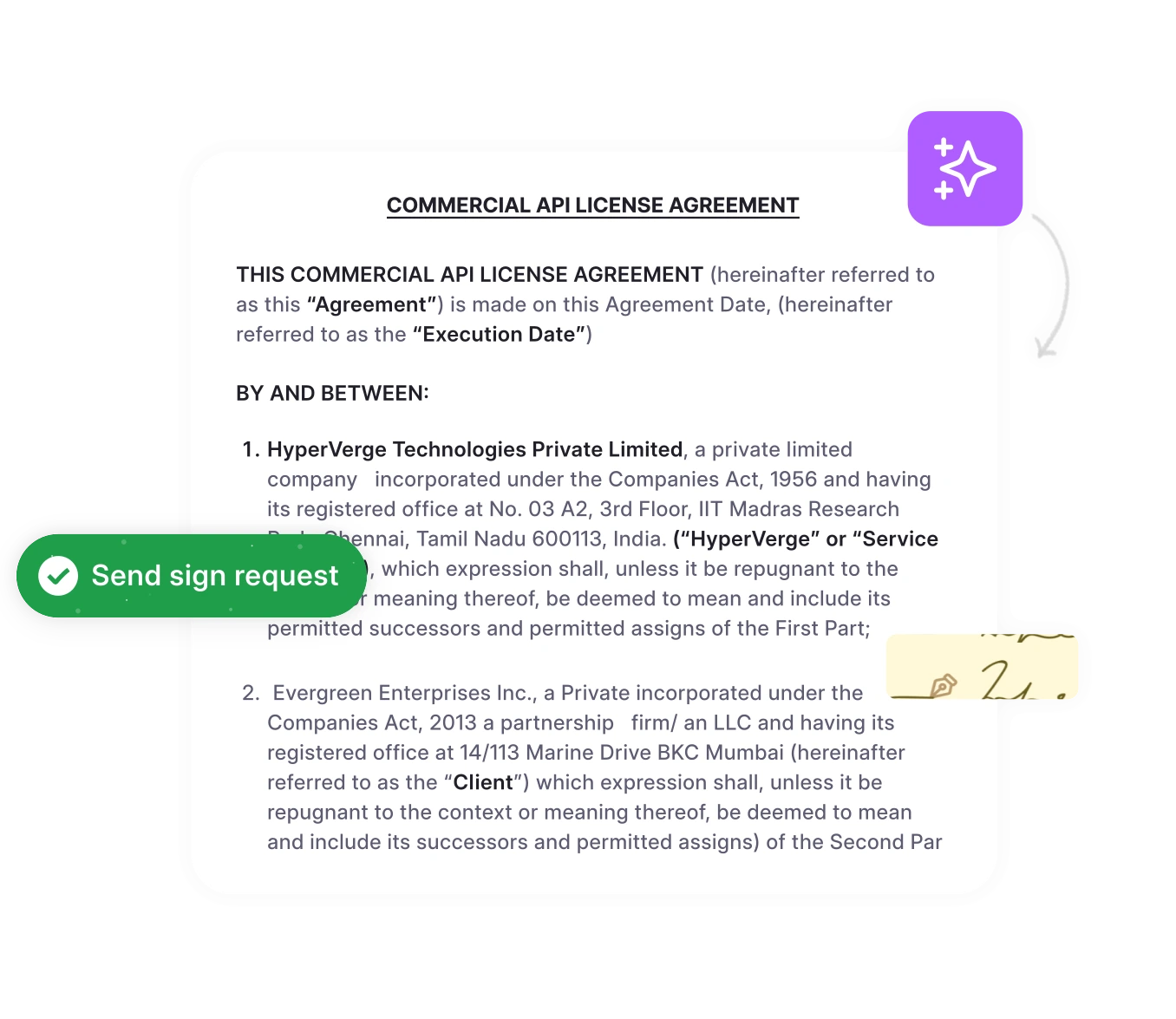The Stock Purchase Agreement is the blueprint that shows how all the pieces of a high-stakes deal fit together. For legal and compliance professionals, managing the due diligence for an SPA is critical.
The typical Fortune 1000 company manages between 20,000 and 40,000 active contracts, of which at least 10% are misplaced, difficult to find, or otherwise unmanaged. This “contract invisibility” can turn M&A due diligence from a strategic process into a frantic, high-risk scavenger hunt.
This guide will not only break down what an SPA is and how it works but will also show you how modern Contract Lifecycle Management (CLM), powered by AI, can transform this operational busywork into business.
So, what is a stock purchase agreement?
A Stock Purchase Agreement (SPA) is a legally binding contract that lays out all the terms for the sale of a company’s shares from a seller to a buyer. Instead of picking and choosing specific assets, the buyer is acquiring the entire corporate entity, lock, stock, and barrel. You get all the assets. You also inherit all the liabilities. Both known and unknown. The business continues to operate under your ownership, just with a new shareholder at the helm. Sometimes called a share purchase agreement, think of it as the complete rulebook for buying a business.
The big question: Stock purchase vs. asset purchase?
This is the most common point of confusion in corporate transactions. It all comes down to what you’re actually buying.
| Feature | Stock Purchase Agreement (SPA) | Asset Purchase Agreement (APA) |
| What You Acquire | The entire legal entity and all its outstanding capital stock. | Specific, chosen assets (equipment, IP, client lists). |
| Liabilities | The buyer assumes all liabilities (known and hidden). | Buyer typically avoids most legacy liabilities. |
| Legal Structure | The company’s business continues uninterrupted. | A new or existing entity of the buyer purchases the assets. |
| Complexity | Often simpler for the seller, due diligence is critical for the buyer. | Can be more complex, as each asset must be transferred. |
| Tax Implications | Sellers often prefer this for potential tax advantages. This includes complex tax matters like the allocation of the purchase price. | Buyers often prefer this for the ability to “step-up” the asset basis. |
What’s inside the stock purchase agreement?
While it’s a dense document, its core components are fairly consistent. Here’s what to include when writing the contract.
The parties and the purchase price
It clearly identifies the buyer and the seller (which could be an individual shareholder or multiple shareholders) and specifies the class of shares being sold (e.g., common stock). It also details the purchase price, which is often subject to adjustment based on the company’s financial condition at closing, such as working capital levels.
Representations and warranties
These are promises qualified by the mutual knowledge of these promises. The seller makes a series of statements about the business, covering everything from the accuracy of its financial statements and the status of its IP, compliance with laws and the absence of pending litigation. The buyer also makes reps, typically about their authority to enter the agreement and their ability to pay. If these promises turn out to be false, they form the basis for an indemnification claim later. The seller will make specific representations about tax matters, affirming that all tax returns have been filed and all taxes paid, to protect the buyer from hidden liabilities.
Covenants
These are the “dos and don’ts” that both parties agree to follow between signing the SPA and the official closing date. For the seller, this usually means promising to run the business in the ordinary course and not to take on new major debts or sell key assets. For the buyer, it might include agreeing to a non-solicitation of the seller’s key employees for a set period.
Read about M&A Exclusivity Agreements
Conditions to closing
This is the final checklist. The deal won’t close until every item is ticked off. Common closing conditions include obtaining regulatory approvals, getting third-party consents, and ensuring all representations and warranties are still true as of the closing date.
Indemnification
This is the “what if it goes wrong” clause. Indemnification provisions outline how the seller agrees to hold harmless the buyer for losses from breaches of their promise after the sale. This is the buyer’s primary legal recourse for discovering a hidden liability after the fact. These provisions are also tightly linked to the ‘Applicable Law’ clause, which determines which state’s laws will be used to interpret the agreement and any disputes that arise from it.
Intellectual Property
This is often where a huge part of the company’s value lives, so the buyer will dig deep here. The sellers have to make specific promises that they actually own all the IP they claim to—things like patents, trademarks, software code, and trade secrets—and that it’s all properly protected. They also have to confirm that the business hasn’t infringed on anyone else’s rights and isn’t facing any IP lawsuits.
In short, the stock purchase agreement boils down to a few key promises: what you’re buying, what you’re being told is true, what you can and can’t do before the deal is final, and what happens if something goes wrong.
The negotiation disconnect: What we argue about vs. what causes problems
In M&A and other commercial contracts, there’s a consistent gap between the terms negotiators focus on and the terms that cause problems during performance.
Most negotiated terms (MNT)
| Rank | Term (Overall) | Insight for Legal Professionals |
| 1 | Limitation of Liability | Focuses on legal consequence control. |
| 2 | Price / Charge / Price Changes | A critical commercial term often tied to dispute. |
| 3 | Indemnification | Directly determines risk allocation in case of loss. |
Most disputed terms (MDT)
| Rank | Term (Overall) | Insight for Legal Professionals |
| 1 | Price / Charge / Price Changes | Disputes suggest mutual misunderstanding or inadequate flexibility was built in. |
| 2 | Scope and Goals / Specification | Failure to clearly define or align on scope is a major source of conflict. |
| 3 | Delivery | Misunderstandings regarding timelines create friction. |
Only 16% of contract negotiators believe that they are negotiating the right things, underscoring the universal struggle to focus on relevant outcomes.
Read also 8 Proven Strategies for Negotiating Vendor Contracts
Systemic gaps that create M&A risk
Expert insights from contract data reveal systemic weaknesses that translate directly to M&A risk. During due diligence, it’s not just about finding contracts, it’s about assessing their quality. Reviews often uncover systemic weaknesses that translate directly to risk:
- Poor Performance Tracking: Over 75% of contracts failed to include an exhaustive set of Key Performance Indicators (KPIs).
- No Market Benchmarking: 80% lacked a benchmarking clause for periodic price reviews.
- Inflation Risk: Nearly 40% had no cap on pricing adjustments for inflation.
- Static Agreements: Almost 20% had no defined process for continuous improvement.
Read also Legal Contract Management Insights for In-House Counsel
The SME power imbalance
When the target company is a small or medium-sized enterprise (SME), the dynamics change. The negotiation landscape is often characterized by high pressure and inflexibility:
- 88% of SMEs believe large businesses are inflexible in negotiations.
- 78% feel pressured to accept unfavorable terms.
Leveraging AI for due diligence and discovery
According to expert insights from Axiom’s Deputy General Counsel Survey Report, the administrative burden on legal teams is disproportionately large compared to legal budgets. This impacts their ability to focus on high-value work.
- Workload Increase: 99% of Legal teams report a rise in volume and complexity of work.
- Under-Resourced: 92% of Legal teams believe their departments are under-resourced.
HyperStart’s proprietary AI directly addresses the core pain points faced by legal teams during M&A due diligence.
How AI transforms the due diligence process
According to industry data, legal professionals are beginning to trust AI tools to perform specific tasks, such as tagging contract metadata (34%) and flagging risky clauses (33%).
- Search and Analysis: AI allows you to efficiently search thousands of stored contracts, moving your function to a”System of Intelligence.”Imagine instantly querying for all contracts containing specific indemnification language or change of control clauses across the target company’s entire portfolio.
- Intelligent Clause Extraction: AI can extract essential metadata and clauses in seconds, surfacing critical intelligence on M&A concerns. This means you can analyze events of default clauses in real-time during a partner meeting.
- Accelerated Review: Teams using legal AI tools can review contracts up to 60% faster, drastically expediting the process of finding and analyzing contracts.
The bottom line: By focusing on technologies that organize and intelligently extract data from inherited contract portfolios, Legal and Compliance teams can become key strategic partners throughout the M&A lifecycle.
In closing
An SPA has multiple critical data points. HyperStart helps you manage every clause and condition, from initial due diligence to commitment after final closing, so you can execute deals with confidence.
Leveraging AI-powered CLM to manage the due diligence and integration process is what separates overwhelmed legal teams from true strategic partners.












